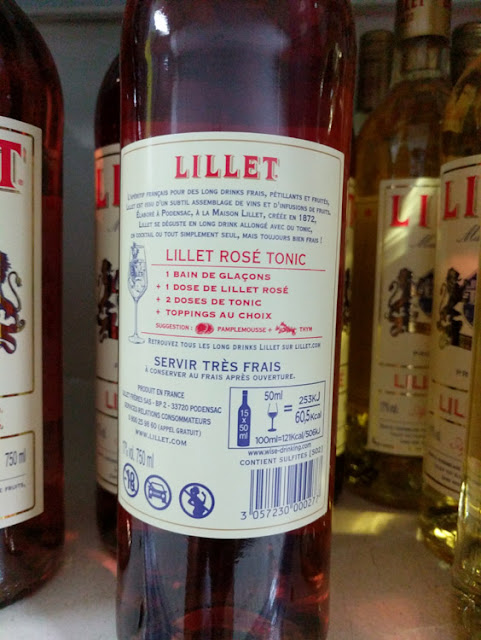Created 150 years ago, Lillet (pronounced lee-lay) is once again fashionable.
Lillet and a non-alcoholic alternative on the bar at L'Image in Preuilly sur Claise.
Until a few years ago it had been something only your granny drank. But thanks to a vigorous promotional campaign in the drinks industry by Pernod-Ricard, the parent company of the producers of Lillet, it is now exported to about 50 countries around the world. Nowadays it is no longer consumed as a digestive, but as a cocktail ingredient, especially simple spritzers.
The back label on a Lillet rosé bottle in the supermarket.
Coming in white, pink or red versions, Lillet is an aperitif from Bordeaux which is now back in the limelight, having long been considered obsolete. Lillet is only made at one distillery, at Podensac in the Gironde.
Every morning 60 000 litres of Bordeaux wine is delivered to the factory. The recipe is secret, but Lillet is 85% wine from the region, some quinine and 15% fruit liqueur which has macerated in a oak barrel at the factory. Once all the ingredients are mixed it then sits in barrels made from locally grown low tannin oak for a further two to four months. It is not herbal, like a vermouth would be. Instead the bitterness comes from citrus and quinine. Then in 1985 the secret recipe was reformulated to reduce both the quinine content and the amount of sugar. And in 2011 Lillet Rosé was released, made from a more complex mixture of fruits than either the red or the white.
White and rosé Lillet at the supermarket.
Ten million litres were made in 2022, compared to 800 000 litres in the 1930s, and ten times what was made in 2014. The drink we know today was invented in 1887, by Raymond and Paul Lillet, two brothers who were wine merchants (Fr. négociants), using Sauternes, although there was an earlier version dating from 1872. Its heyday was considered to be in the 1950s and 60s, when the American market discovered the drink. The company remained family owned for 113 years, until 2016 when Raymond's grandson, Pierre Lillet, died. Today Germany and Austria are big consumers, and although Britain and the US remain important, they are considered more as historically where it was consumed in the 20th century.
Lillet isn't nearly as alcoholic as some of its competitors, and is more like a fortified wine than a spirit. Technically it is an aromatised wine-based aperitif. That gives it a good deal of versatility and it can be paired with white meat, cheeses and desserts or used as an ingredient in chicken dishes or desserts, rather than just used as an aperitif or a cocktail ingredient. But most famously it was used in the Vesper Martini, James Bond's staple drink.
Lillet in the supermarket.
The company is proud of its sustainable practices, using tankers fueled by bioethanol and composting all grape waste. Packaging, including the bottles, are lightweight and untreated.
It is recommended to keep Lillet in the fridge once opened. In modern bars and households it is served with tonic, lots of ice and a garnish like a strawberry.





2 comments:
It was on offer as an apero at our Mayor's home and Mdm was drinking it so I signed up for it too. We bought a bottle or two afterwards, but our guests were into The Wine so a bottle lasted too long for just me! I like the idea of Pink! Lesley
We often have a bottle on the go, usually white but sometimes rosé. It's a very pleasant drink and first came across it on our holiday in St Emilion a few years ago where it was offered as an aperitif in one of the restaurants. We visited the factory shop in Podensac too. All very nice and I'm glad it's not fallen by the wayside.
I'm sure I have seen it for sale in UK supermarkets, possibly Sainsbury's.
Post a Comment